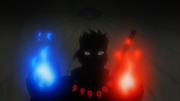(discussion not yet over, deletion was proposed years ago already) |
mNo edit summary |
||
| Line 1: | Line 1: | ||
{{Infobox/Jutsu |
{{Infobox/Jutsu |
||
| ⚫ | |||
| + | |||
|image=Babutsu Sozo.png |
|image=Babutsu Sozo.png |
||
|kanji=万物創造 |
|kanji=万物創造 |
||
| Line 13: | Line 15: | ||
|jutsu media=Anime, Manga |
|jutsu media=Anime, Manga |
||
}} |
}} |
||
| ⚫ | |||
The {{Translation|'''Creation of All Things'''|万物創造|Banbutsu Sōzō}} was an ability possessed by Hagoromo Ōtsutsuki, who used it to create the nine [[tailed beasts]]. The process he used is explained to have initially involved the administration of imagination, and the spiritual energy which forms the basis of [[Yin]] [[chakra]] to create physical forms from nothingness. Then, through the application of vitality, and the physical energy which forms the basis of [[Yang]] chakra, he would breathe life into the resulting creations. |
The {{Translation|'''Creation of All Things'''|万物創造|Banbutsu Sōzō}} was an ability possessed by Hagoromo Ōtsutsuki, who used it to create the nine [[tailed beasts]]. The process he used is explained to have initially involved the administration of imagination, and the spiritual energy which forms the basis of [[Yin]] [[chakra]] to create physical forms from nothingness. Then, through the application of vitality, and the physical energy which forms the basis of [[Yang]] chakra, he would breathe life into the resulting creations. |
||
Revision as of 14:30, 5 February 2015
The Creation of All Things (万物創造, Banbutsu Sōzō) was an ability possessed by Hagoromo Ōtsutsuki, who used it to create the nine tailed beasts. The process he used is explained to have initially involved the administration of imagination, and the spiritual energy which forms the basis of Yin chakra to create physical forms from nothingness. Then, through the application of vitality, and the physical energy which forms the basis of Yang chakra, he would breathe life into the resulting creations.
Trivia
See Also
References
- ↑ Chapter 510, page 11

